Abstract
In this article I analyze the early years of Ultra Cultura Contemporánea. Revista de revistas, published in Havana by Cuban ethnologist Fernando Ortiz between 1936 and 1947. My focus is to explore the role that science has in the definition of culture that this clipping magazine states as a cultural project. I suggest that the clippings of US popular science journals such as Popular Science (1872-today) and Science (1880-today) that Ultra publishes and the translation processes they undergo in the journal are part of a transcultural praxis. Through this praxis, Ultra promotes an ecology of knowledge, inscribing foreign technique in trajectories which interrupt the definitions of life in the years prior to World War II from Ortiz's vitalist materialism. This materialism is expressed in the magazine's editorials from an arborescent imaginary, conceiving nature and culture within a continuum.
References
Barad, Karen. Meeting the Universe Halfway. Quantum Physics and the Entanglement of Matter and Meaning. Durham and London: Duke University Press, 2007.
Bennett, Jane. “Edible matter” Vibrant Matter. A Political Ecology of Things. Durham and London: Duke University Press, 2010.
Degiovanni, Fernando. Vernacular Latin Americanisms. War, the Market and the Making of a Discipline. Pittsburgh: University of Pittsburgh Press, 2018.
Frost, Samantha. Biocultural Creatures: Toward a New Theory of the Human. Durham: Duke University Press, 2016.
Gilman, Claudia. “Equívocos semánticos sobre transculturación y vacilaciones disciplinarias”. Revista del Museo de Antropología 9 (2): 153-160.
Gross, Kenneth. Puppet: An Essay on Uncanny Life. Chicago and London: The University of Chicago Press, 2011.
Hoyos, Héctor. Things with a History. Transcultural Materialism and Literatures of Extraction in Contemporary Latin America. New York: Columbia University Press, 2019.
Latour, Bruno. “Esas redes que la razón ignora: laboratorios, bibliotecas, colecciones”. Retos de la Postmodernidad. Eds. Fernando J. García Selgas y José B. Monleón. Madrid: Trotta, 1999. 161-183. Disponible en https://cutt.ly/6mTUIiA
Naranjo-Orovio, Consuelo. Fernando Ortiz Fernández: Apuntes biográficos (Cuba, La Habana 16 de julio de 1881-10 de abril de 1969). Madrid: Fundación Ignacio Larramendi, 2016
Ortiz, Fernando. Contrapunteo cubano del tabaco y el azúcar. Caracas: Biblioteca Ayacucho, 1987.
Ortiz, Fernando. “La cubanidad y los negros” en Estudios afrocubanos, La Habana, vol. III (1939).
Rama, Ángel. Transculturación narrativa en América Latina. 4ª ed. México D.F./ Buenos Aires/ Madrid: Siglo XXI, 2004.
Siskind, Mariano. Deseos cosmopolitas. Modernidad global y literatura mundial en América Latina. Buenos Aires: Fondo de Cultura Económica 2016.
Sousa Santos, Boaventura de. Descolonizar el saber, reinventar el poder. Montevideo: Ediciones Trilce; Universidad de la República, 2010.
Stengers, Isabelle. En tiempos de Catástrofes. Cómo sobrevivir a la barbarie que viene. Barcelona/ Buenos Aires: NED/ Futuro Anterior, 2017.
Te Heesen, Anke. The Newspaper Clipping. A Modern Paper Object. Manchester & New York: Manchester U.P., 2014.
Vessuri, Hebe M. C. “La ciencia académica en América Latina en el siglo XX”. Redes: Revista de estudios sociales de la ciencia, 1, 2 (1994) 41-76. Disponible en https://cutt.ly/cmTUgKu
Viu, Antonia. Materialidades de lo impreso. Revistas Latinoamericanas 1910-1950. Santiago: Metales Pesados, 2019.
Revistas
Anónimo. “Chemical Process Rustproofs Metal.” Popular Science. Vol. 129 N.º 5 (noviembre 1936): 29.
Anónimo. “El arte de los títeres”. Ultra Cultura Contemporánea. Revista de Revistas. Vol. II No 8 (febrero 1937): 179- 182.
Anónimo.“Libertad Intelectual”. Ultra Cultura Contemporánea. Revista de Revistas. Vol. VI-VII N.º 32 (febrero 1939): 97-98.
Anónimo. “Intellectual Freedom”. Science. Vol. 87, N.º 2245 (7 enero 1938): 10.
Anónimo. “Los fumadores y la longevidad”. Ultra. Vol. VI-VII N.º 31(enero 1939): 65.
Anónimo. “El hombre más rico”. Ultra Cultura Contemporánea. Revista de Revistas. Vol. II N.º 7 (enero 1937): 23.
Anónimo. “Un explosivo azucarado”. Ultra Cultura Contemporánea. Revista de Revistas. Vol. I N.º 2 (agosto 1936):166.
Armagnac, Alden. “New feats of Chemical Wizards Remake the World we Live in”. Popular Science. Vol. 129 N.º 1 (julio 1936): 9-11.
Lord Rayleigh. “Los científicos y la Guerra”. Ultra Cultura Contemporánea. Revista de Revistas. Vol. VI N. º40 (octubre 1939): 34.
Lord Rayleigh. “Vision in Nature and Vision Aided by Science; Science and Warfare”. Science. Vol. 88 N.º 2278 (26 agosto 1938): 175-181.
Lord Rayleigh. “Vision in Nature and Vision Aided by Science; Science and Warfare”. Nature. Vol. 142 N.º 3590 (20 agosto 1938): 327-338.
Fetherstom Drake, Florence. “Hand Puppets. How to Make and Manipulate them”. Popular Science. Vol. 130, N.º 2 (febrero 1937): 84-85.
Pearl, Raymond. “Tobacco Smoking and Longevity”. Science. Vol. 87 N.º 2253 (4 marzo 1938): 216.
Ortiz, Fernando. “Presentación”. Ultra. Cultura Contemporánea. Revista de Revistas. Vol. I N.º1 (julio 1936): 1- 2.
Ortiz, Fernando. “Ya en el tercer año”. Ultra. Cultura Contemporánea. Revista de Revistas. Vol. V N.º25. (julio 1938): 1-2
Ortiz, Fernando. “En el cuarto año”. Ultra. Cultura Contemporánea. Revista de Revistas. Vol. VII N.º37 (julio 1939): 1.
Ortiz, Fernando. “Teatro. Función de Títeres”.Ultra. Cultura Contemporánea. Revista de Revistas. Vol. II Nº7 (enero 1937): 87-88.
Stark, J. “The Pragmatic and the Dogmatic Spirit in Physics”. Nature. Vol. 141 (1938): 770–772.

This work is licensed under a Creative Commons Attribution-NonCommercial 4.0 International License.


